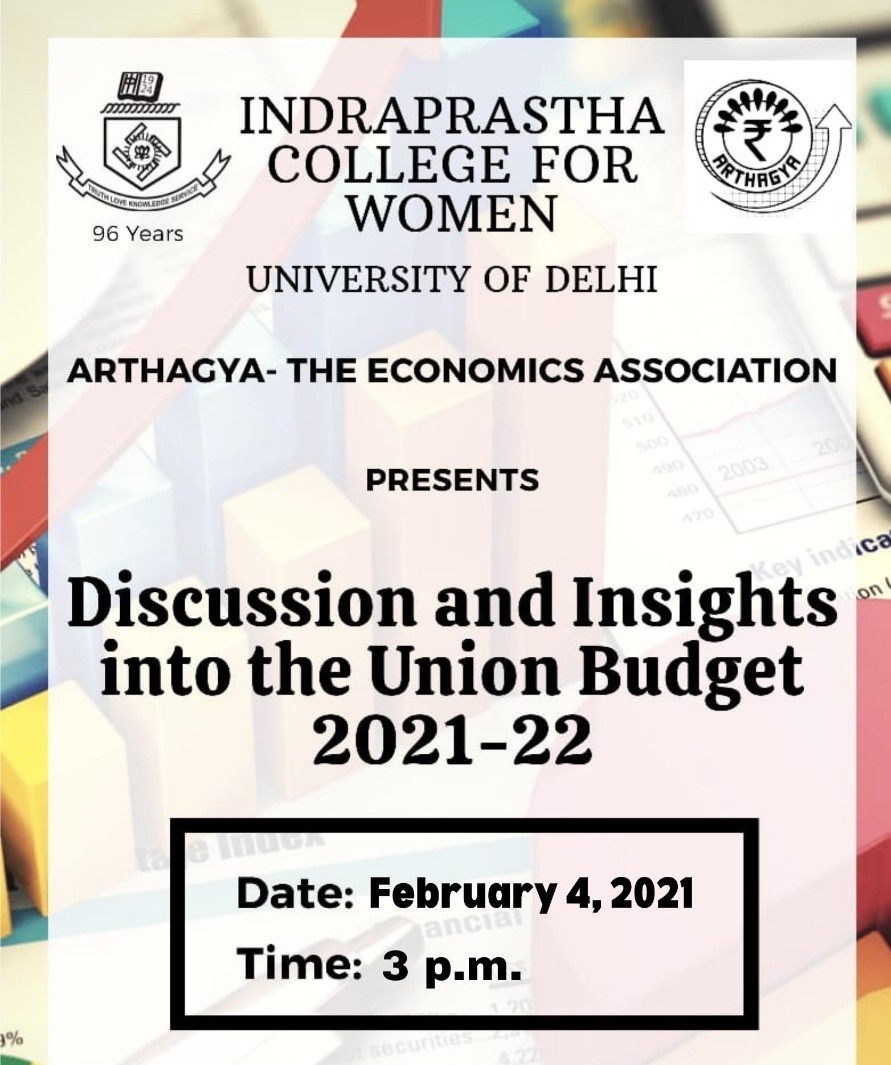Arthagya, the Economics Association of Indraprastha College for Women, held a discussion on the Union Budget, 2021-2022 on Thursday, February 4, 2021, at 3:00 pm. There were altogether eleven participants who discussed crucial aspects of the six pillars of the budget. The event was moderated by Arnaz Shaik, the President of Arthagya.
Vanshika Sighroha, a second-year student of Economics, commenced the discussion by briefly explaining the first pillar of the budget: Health and Well-being. She keenly pointed out that budget allocation has reduced in contrast to the reports that tout a 137% increase in budget outlay for health. To support her point, she pointed that allocation for the Union Health and Family Welfare Ministry increased by 10% than the previous year’s budget estimate; however, it shrunk by 6% compared to the previous year’s revised budget estimate. Other participants concurred with Vanshika by pointing out that the budget for health seems grand only because it includes expenses for water and sanitation and that it will be spread over the course of six years.
Disha Ghosh, a third-year student of Economics, explained the second pillar of the Budget: Physical, Financial Capital, and Infrastructure. She highlighted the institutional frameworks proposed in the budget viz. development financial institutions to deal with corporate bonds and enhance secondary market liquidity, and an Asset Reconstruction Company. Disha opined that although aggregating performing assets into one entity will help bridge bad loan issues, it could end up inflating the price of distressed assets. Participants discussed that the government should have planned to fund Development Financial Institution (DFI) through domestic resources instead of Foreign Portfolio Investment (FPI) given that the entire budget is based on ‘Atma Nirbhar Bharat’.
Priya Suman, a second-year student of Economics, elucidated points of the third pillar, Inclusive Development for Aspirational India. Priya noted that budget allocation for The Mahatma Gandhi National Rural Employment (MGNREGA) is low despite the estimated demand for jobs to surge after a tough year. She argued that it was unsatisfactory to see the government not consider rationalizing The Public Distribution System (PDS) of food grains, including urea under Nutrient Based Subsidy (NBS) or, bring institutional changes in areas like tax administration. Participants expressed despondency to the lack of clarity in measures to boost women’s employment and inadequate funding for nutrition-related schemes.
Gauri Aggarwal, a second-year student of Economics, spelled out the details of the fourth pillar: Reinvigorating Human Capital. She stated that the expenditure on education has gone down from Rs. 99, 311 crores to Rs. 93, 225 crores, which exacerbates the current situation of lack of teachers and proper infrastructure. She also said that spending has not been dedicated to raise the income levels of the most vulnerable sections of society. Other participants noted a need for a vigilance committee to ensure quality exchange between teachers and students in rural schools. The removal of all the restrictions to set up businesses for entrepreneurs was also praised.
Arpita Jain, a second-year student of Economics, described the fifth and sixth pillars of the budget: Innovation and Research & Development, and Minimum Government and Maximum Governance. Commenting on the current fiscal position, Arpita focused on the relevance of deep ocean mission to explore and conserve underwater biodiversity. She noted that the budget deficit stood at 9.8% of the GDP in contrast to the previous year’s estimate at 3.5% of the GDP. Participants highlighted the rationalization, transparency and efficient regulations demonstrated towards capital expenditure and tax revenue collected from the investment which would offset the hefty costs and borrowings of the government in the long run.
Samriddhi Sharma, a second-year student of Economics, explained the second part of the Finance Minister’s budget speech. She said the Agriculture Infrastructure and Development Cess (AIDC) was imposed on many items including fuel and liquor to improve the agriculture infrastructure in the country, and suggested that the eventual burden of AIDC will fall on consumers. Participants noted the budget didn’t incentivize expenditure for the middle class as the price of consumer durable items hikes with an increase in customs duty. The avoidance of tax imposition on cryptocurrency, which is a growing market, was argued to be a missed opportunity for the government to generate revenue from.
Finally, Dr. Prabhjot Kaur, the Faculty Advisor of Arthagya, concluded the session by highlighting the key features of budget, including expenditure on the health sector, manufacturing sector, and construction of infrastructure to steer the economy towards a V-Shaped recovery. She congratulated the participants for demonstrating impressive intellectual dexterity and thanked the audience for listening to the discussion intently.
This event was covered by Annie Shrestha, Correspondent at Prophets of Profit, the Editorial Board of the Economics Department.

